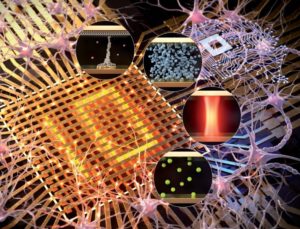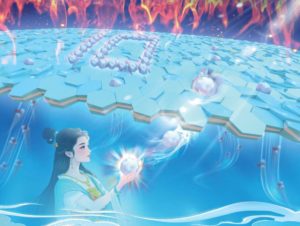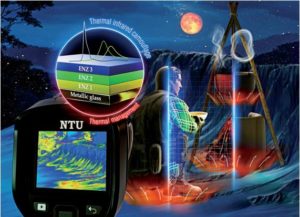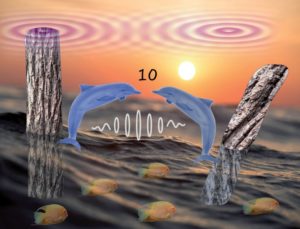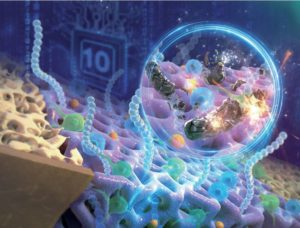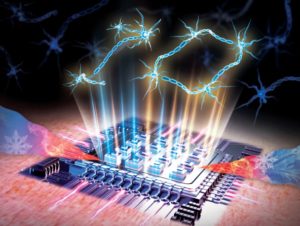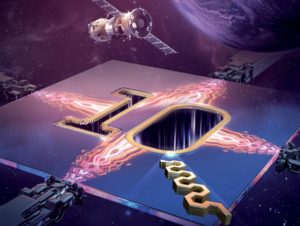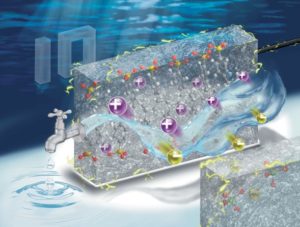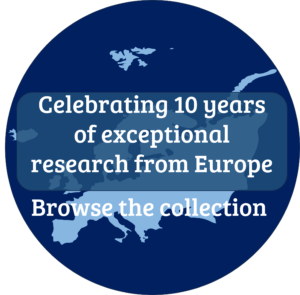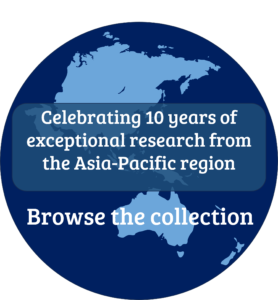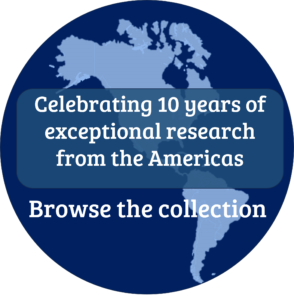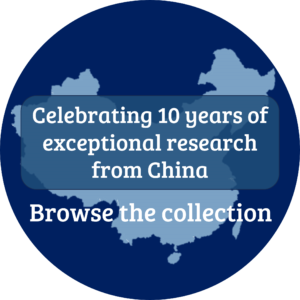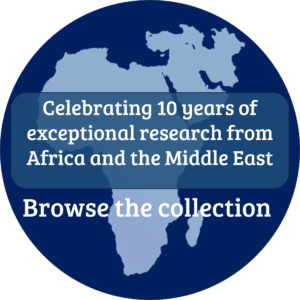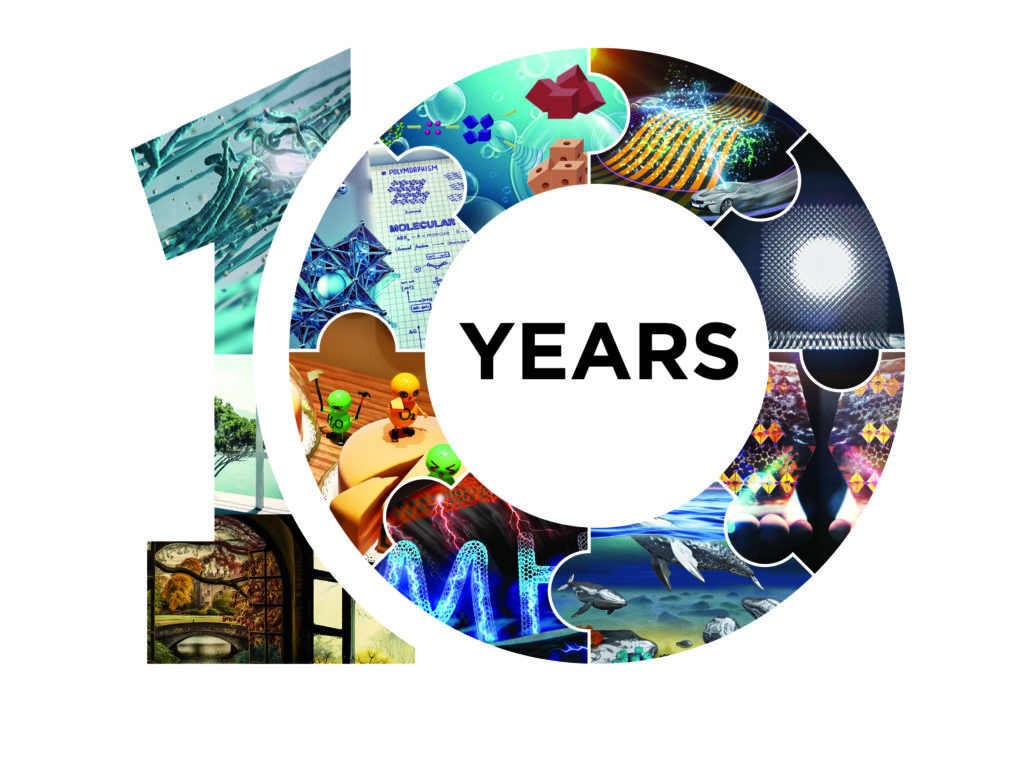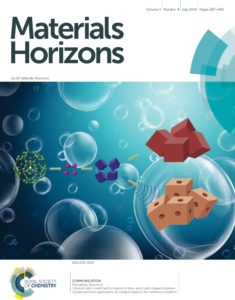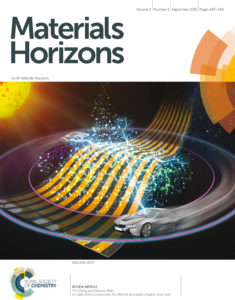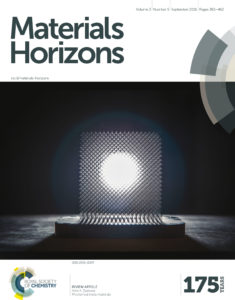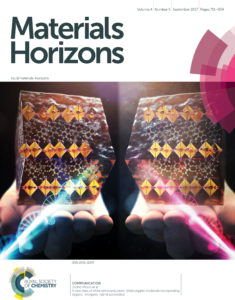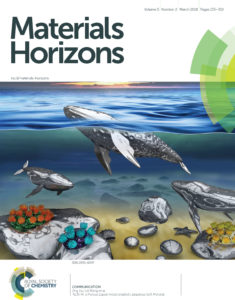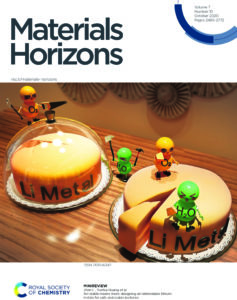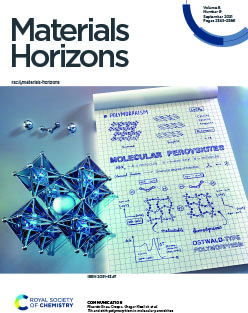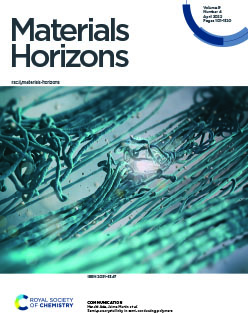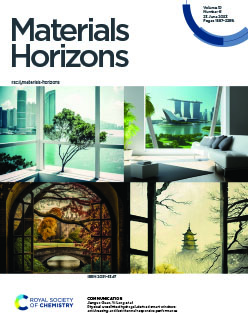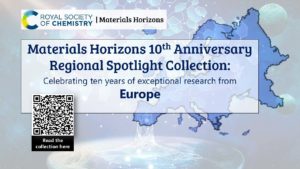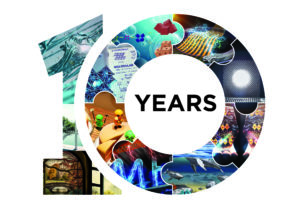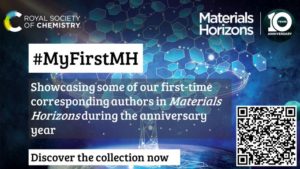Introducing the Materials Horizons Advisory Board – Part 2.
This year we are pleased to celebrate the tenth anniversary of Materials Horizons. We are so grateful to our fantastic community of authors, reviewers, Board members and readers and wanted to showcase just some of them in a series of ‘Community Spotlight’ blog articles.
In this ‘Community Spotlight’, we feature some more of the Advisory Board members who have supported Materials Horizons over the years. We have asked them what they like most about being on the journal’s Advisory Boards, about their recent publications and about their own insights into the future of materials chemistry. Check out their interview responses and related articles below.
| Christopher Bettinger, Advisory Board Member
Carnegie Mellon University, USA |

Christopher Bettinger is a Professor at Carnegie Mellon University in the Departments of Materials Science and Engineering and Biomedical Engineering. He directs the laboratory for Biomaterials-based Microsystems and Electronics at CMU, which designs materials and interfaces that integrate medical devices with the human body. Prof. Bettinger is also a co-inventor on several patents and Co-Founder and CTO of Ancure, an early-stage medical device incubator. Prof. Bettinger received an S.B. in Chemical Engineering, an M.Eng. in Biomedical Engineering, and a Ph.D. in Materials Science and Engineering as a Charles Stark Draper Fellow, all from the Massachusetts Institute of Technology. He completed his post-doctoral fellowship at Stanford University in the Department of Chemical Engineering as an NIH Ruth Kirschstein Fellow.
What do you think of Materials Horizons as a place to publish impactful materials chemistry research?
‘Materials Horizons is a high-impact journal that features multidisciplinary research. The breadth of the articles is impressive and attracts a broad audience that is interested in innovative research. As an author, I am particularly impressed by the efficiency of the review process, and which translates to the ability to publish rapidly. Materials Horizons therefore is a great place to publish for quick moving fields.’
Where do you see the materials chemistry field in the next 10 years?
‘Materials chemistry underpins most of the advanced technologies of our generation ranging from RNA vaccines to clean energy to space travel. The scope and scale of the impact of the materials chemistry field is stunning. I’m personally interested in understanding how biomedical materials can help scientists and engineers interrogate and modulate organ systems such as the gastrointestinal tract.’
You can read Christopher’s latest articles in Journal of Materials Chemistry B here:
Poisson–Nernst–Planck framework for modelling ionic strain and temperature sensors.
Gaurav Balakrishnan, Jiwoo Song, Aditya S. Khair and Christopher J. Bettinger.
J.Mater. Chem. B, 2023,11, 5544-5551. DOI: 10.1039/D2TB02819K
Electrochemical-mediated gelation of catechol-bearing hydrogels based on multimodal crosslinking.
Chenchen Mou, Faisal Ali, Avishi Malaviya and Christopher J. Bettinger.
J.Mater. Chem. B, 2019,7, 1690-1696. DOI: 10.1039/C8TB02854K
| Ramanathan Vaidhyanathan, Advisory Board Member
IISER Pune, India |

Dr. R. Vaidhyanathan obtained his Ph.D. from the Jawaharlal Nehru Centre for Advanced Scientific Research under Prof. C. N. R. Rao and Prof. S. Natarajan. He worked as a postdoc with Prof. M. J. Rosseinsky at the University of Liverpool and as a research associate with Prof. George Shimizu at the University of Calgary. He started his independent research career as an assistant professor in IISER Pune in 2012. Currently, he is a Professor at IISER Pune. His research focuses on developing Advanced Porous Materials such as metal-organic frameworks (MOFs) and covalent-organic frameworks (COFs) and their nanocomposites for environmental and energy applications. He has published over 102 papers and has 11 patents filed from IISER Pune. He has been rewarded with several honours, including the Fellowship of Royal Society of Chemistry (2022), C.N.R. Rao Award. National Prize for research in Physical and Inorganic Chemistry (2021), Materials Research Society of India Medal (2019), Chemical Research Society of India Medal (2018), IUSSTF funding won jointly with Temple University (Chief Co-PI, 2018), Sakurai Science Program (SSP), Osaka University, Japan (2016), Best Emerging Young Scientist (Chemical Frontiers), Goa, (2017). He serves as an Associate Editor in Chemistry of Materials and as an Editorial Board Member of ACS Materials Letters and Nature Scientific Reports. He is the Advisory Board Member of Nanoscale Horizons and Materials Horizons.
What do you like most about being on the Advisory Board for Materials Horizons?
‘Excellent opportunity. Such a fantastic journal covering a whole spectrum of materials. Being an Advisory Board Member gives me the commitment and responsibility to bring visibility and promote the latest happenings and upcoming young researchers in porous materials.’
What do you think of Materials Horizons as a place to publish impactful materials chemistry research?
‘Again, among the top materials journals, the editorial and marketing teams are engaged in promoting the published articles. This is very critical for many researchers who work on topical areas. Importantly, the “concept note” for every article published in Materials Horizons provides a plain language note of the work, making it reachable to a wide scientific audience and opening collaboration opportunities.’
Where do you see the materials chemistry field in the next 10 years?
‘Nothing but top. It has become such a fantastic interdisciplinary research area. Nowadays, very little work happens within individual groups. The rapid development of technology and the excellent government support for research from many developing and almost-developed countries has expanded the capability of individual groups. Now many active groups are not ready to settle for only fundamental investigations; there is a vibrant, collaborative environment between groups leading to research in materials that is more targeted and holistic. Given this, I see Materials Chemistry inciting every field of Science and Technology.’
In your opinion, how could members of the community be more involved with the journal?
‘I see the materials journals of RSC being extremely focused and active in communicating with the members and encouraging them to contribute to specialized topics. And their attempt to invite senior researchers to nominate, support and endorse high-flying young researchers is simply superb. Keep going.’
Could you provide a summary of your most recent Materials Horizons publication?
‘I would not call it the most recent, but we have published an excellent work on flexible MOFs. We employed the concept of “Hard Soft Gate Control (HSGC)” which involves tuning the openness of the MOF framework by exploiting the coordination flexibility between the metal and the basic ligand by tuning the metal’s hardness. It resulted from an intense collaboration between Woo and co-workers from U Ottawa and us.’
Discover some of Ramanathan’s work across our Horizons journals here:
Imparting gas selective and pressure dependent porosity into a non-porous solid via coordination flexibility.
Shyamapada Nandi, Phil De Luna, Rahul Maity, Debanjan Chakraborty, Thomas Daff, Thomas Burns, Tom K. Woo and Ramanathan Vaidhyanathan.
Mater. Horiz., 2019,6, 1883-1891. DOI: 10.1039/c9mh00133f
Hydroxide ion-conducting viologen–bakelite organic frameworks for flexible solid-state zinc–air battery applications.
Deepak Rase, Rajith Illathvalappil, Himan Dev Singh, Pragalbh Shekhar, Liya S Leo, Debanjan Chakraborty, Sattwick Haldar, Ankita Shelke, Thalasseril G. Ajithkumarc and Ramanathan Vaidhyanathan.
Nanoscale Horiz., 2023,8, 224-234. DOI: 10.1039/d2nh00455k
| Moyuan Cao, Advisory Board Member
Nankai University, China. |

Dr. Moyuan Cao is currently a professor and principal investigator at school of materials science and engineering, Nankai University, China. He received his B. Eng. Degree (2010) and M. Sc. Degree (2013) in Macromolecular Science and Engineering from Zhejiang University, China. In 2016, he received Ph. D. Degree in materials sciences under the supervision of Prof. Lei Jiang at Beihang University and Chinese Academy of Sciences. He is also a member of Haihe Laboratory of Sustainable Chemical Transformations (Tianjin, China) and Smart Sensing Interdisciplinary Science Center of Nankai University. He has published over 70 peer-review papers in Matter, Adv. Mater., Mater. Horiz., Adv. Funct. Mater., etc. His citation number is over 4600 times with an H-index of 36. He serves as Editorial member of Frontiers in Chemistry, Polymers, Chinese Chemical Letters, Transactions of Tianjin University and Advisory board member of Materials Horizons. His present scientific interests are focused on the design and the applications of bio-inspired asymmetrical interfaces for fluid manipulation, including (1) Self-propelled fluid delivery on open interfaces; (2) Bubble manipulation on hydrophobic slippery surfaces; (3) Integrated systems with fluid collecting ability.
Where do you see the materials chemistry field in the next 10 years?
‘As for the research field in next 10 years, human beings should overcome the shortage of resources including water, energy, food, etc. For example, the drinking water scarcity has influenced the millions of people in undeveloped country. In such region, the complicated equipment such as membrane systems might not be suitable due to the high cost. Therefore, the future research should focus on the drinking water production with more convenient and efficient way. Learning from nature can give us numerous ideas. Why can plants efficiently uptake clear water from mud? How did plant capture and reserve water in arid region? How can we take those inspirations to our design? If we can totally understand the biologic logic of water uptake, I believe that we can further improve the current systems for water production. What I can see is that the combination between the hierarchical structure of plants and the solar absorbing system should be a possible answer to biologic water uptake. So, in the next 10 years, the solar-assisted water production and liquid manipulation can be an important interdisciplinary topic that relating to water, energy, agriculture and integrated functional devices.’
Could you provide a summary of your most recent Materials Horizons publication?
‘In our recent publication in Materials Horizons (2022, 9, 1888), we have fully revealed the superior floatability of Pistia stratiotes that is a kind of aquatic plants. Compared with the traditional lotus leaf, Pistia stratiotes has improved floatability on the basis of its penetrable superhydrophobic/hydrophilic Janus structure. Even when pushed into water, Pistia can spontaneously return to its original orientation on the water surface, and the on-surface leftover water can be actively drained through its liquid channel. Inspired by this natural design, we have fabricated an interfacial tumbler with similar structure, showing an improved floatability. In addition, we have also demonstrated a micro-light-buoy based on this bioinspired floater, which can meet the requirement of floatable microdevice and on-sea signaling. In this publication, we have updated the understand of the floatability of Pistia, and then design a bioinspired structure to optimize the micro-floater. In future, the on-water or on-sea micro-devices should be a promising platform for detection, desalination, imaging, etc. Therefore, our design can also provide a method to stabilize the functional devices at air/water interface. We are interested in discovering the nature’s secrets and learning from nature’s way. ‘
Check out Muyuan’s latest Materials Horizons articles here:
Designing a slippery/superaerophobic hierarchical open channel for reliable and versatile underwater gas delivery.
Xinsheng Wang, Haoyu Bai, Zhe Li, Yaru Tian, Tianhong Zhaoa and Moyuan Cao.
Mater. Horiz., 2023,10, 3351-3359. DOI: 10.1039/D3MH00898C
An interfacial floating tumbler with a penetrable structure and Janus wettability inspired by Pistia stratiotes.
Yifan Yang, Haoyu Bai, Muqian Li, Zhe Li, Xinsheng Wang, Pengwei Wang and Moyuan Cao.
Mater. Horiz., 2022,9, 1888-1895. DOI: 10.1039/D2MH00361A
| Vivian Wing Wah Yam, Advisory Board Member
The University of Hong Kong, China |
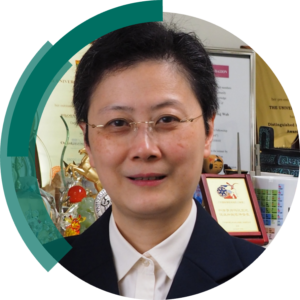
Vivian W.-W. Yam obtained both her BSc (Hons) and PhD from The University of Hong Kong, and is currently the Philip Wong Wilson Wong Professor in Chemistry and Energy and Chair Professor of Chemistry at The University of Hong Kong. She was elected to Member of Chinese Academy of Sciences, International Member (Foreign Associate) of US National Academy of Sciences, Foreign Member of Academia Europaea, Fellow of TWAS and Founding Member of Hong Kong Academy of Sciences. She was Laureate of the 2011 L’Oréal-UNESCO For Women in Science Award. She has received a number of awards, including the Josef Michl ACS Award in Photochemistry, RSC Centenary Medal, RSC Ludwig Mond Award, Porter Medal, Bailar Medal, I-APS Presidential Award, FACS Foundation Lectureship Award, APA Masuhara Lectureship Award, JPA Honda-Fujishima Lectureship Award, JPA Eikohsha Award, JSCC International Award, State Natural Science Award, CCS-China Petroleum & Chemical Corporation (Sinopec) Chemistry Contribution Prize, CCS Huang Yao-Zeng Organometallic Chemistry Award, etc. Her research interests include inorganic/organometallic chemistry, supramolecular chemistry and controlled assembly of nanostructures, photophysics and photochemistry, and metal-based molecular and nano-assembled functional materials for sensing, organic optoelectronics and energy research.
What do you like most about being on the Advisory Board for Materials Horizons?
‘Being on the Advisory Board for Materials Horizons, I am pleased that we are involved in a lot of decision-making. It is running on a highly transparent and open system. We are given opportunities to vote on different things, such as the outstanding papers awards, the top covers, and to provide nominations and suggestions, or to be involved in Horizons Symposia etc. We are also provided with the most up-to-date information on the developments of Materials Horizons.’
Could you provide a summary of your most recent Materials Horizons publication?
‘The team of the Department of Chemistry in The University of Hong Kong showcased for the first time a new class of robust gold(III) complexes with promising operational half-lifetime of more than 200,000 hours. The findings have been published in the special issue of Materials Horizons in honour of Professor Seth Marder (Mater. Horiz., 2022, 9, 281–293). Our most recent Materials Horizons publication (Mater. Horiz., 2022, 9, 281) reported the design and synthesis of yellow- to red-emitting gold(III) complexes and their applications in operationally stable organic light-emitting devices (OLEDs).
We showed that gold(III) complexes can display unprecedented room-temperature phosphorescence both in solution and in the solid state in 1993, and have since designed luminescent gold(III) systems and reported for the first time the use of phosphorescent gold(III) emitters in OLEDs in 2005. Through systematic spectroscopic and photophysical studies, together with rational molecular design and optimization of the molecular structure, their performances have since been increasingly improved towards practical device performance. Through the delicate balance of the radical anion stability and the resonance structures of the N-heterocyclic moieties introduced onto the cyclometalating ligand, a proper choice of the isomers is found to be the determining factor for the realization of high operational stability in these gold(III) complexes. The isomeric effect and extended π-conjugation of the N-heterocycles are shown to remarkably perturb the photophysical, electrochemical and electroluminescence properties of these gold(III) complexes. This has led to high device operational stabilities with long half-lifetime reaching 206,800 hours and maximum external quantum efficiencies of 14.5% in the vacuum-deposited devices, representing the longest operational half-lifetime as well as the highest EQE among the orange-emitting gold(III)-based devices reported so far at that time. This work has provided mechanistic insights and would have significant and important impact on the research and development of luminescent gold(III) complexes.’
Read Vivian W.W’ s latest articles across the Materials journals here:
Design and synthesis of yellow- to red-emitting gold(iii) complexes containing isomeric thienopyridine and thienoquinoline moieties and their applications in operationally stable organic light-emitting devices.
Lok-Kwan Li, Cathay Chai Au-Yeung, Man-Chung Tang, Shiu-Lun Lai, Wai-Lung Cheung, Maggie Ng, Mei-Yee Chan and Vivian Wing-Wah Yam.
Mater. Horiz., 2022,9, 281-293. DOI:10.1039/d1mh00821h
Synthesis and photoswitchable amphiphilicity and self-assembly properties of photochromic spiropyran derivatives.
Yiwei Zhang, Maggie Ng, Eugene Yau-Hin Hong, Alan Kwun-Wa Chan, Nathan Man-Wai Wu, Michael Ho-Yeung Chan, Lixin Wu and Vivian Wing-Wah Yam.
J. Mater. Chem. C, 2020,8, 13676-13685. DOI: 10.1039/d0tc03301d
| Darren Lipomi, Advisory Board Member
UC San Diego, USA |

Darren J. Lipomi is a Professor of nanoengineering, chemical engineering, and materials Science at UC San Diego. He is also the Associate Dean for Students and the Faculty Director of the IDEA Engineering Student Center at the Jacobs School of Engineering at UCSD. Lipomi earned his bachelor’s degree in chemistry with a minor in physics as a Beckman Scholar at Boston University in 2005, and his PhD in chemistry at Harvard University in 2010, with Prof. George M. Whitesides. From 2010 – 2012, he was an Intelligence Community Postdoctoral Fellow in the laboratory of Prof. Zhenan Bao at Stanford University, and arrived at UCSD in 2012. His research interests include the chemistry of organic materials, especially the mechanical properties of semiconducting polymers for flexible solar cells, biomechanical sensors, and phenomena that occur at the intersection of materials chemistry with human perception and cognition. He is the recipient of the AFOSR Young Investigator award, the NIH Director’s New Innovator Award, the Presidential Early Career Award for Scientists and Engineers (PECASE), and the NSF BRITE-Pivot award. He hosts a podcast, “Molecular Podcasting with Darren Lipomi” and associated YouTube channel (Darren_Lipomi) that together have >15,000 subscribers. These venues serve as a resource to students, postdocs, and other early-career researchers.
What do you like most about being on the Advisory Board for Materials Horizons?
‘Serving on the Advisory Board for Materials Horizons has been a true privilege. The multifaceted nature of this role, which allows me to engage with authors, editors, and editorial staff, is what I find most gratifying. I have been pleased to have the opportunity to shape the direction of the journal and influence the discourse within the scientific community. I have especially enjoyed interacting with my fellow board members, who come from a broad swath of the materials science community.’
Where do you see the materials chemistry field in the next 10 years?
‘The next decade holds great promise for materials science, in particular increased interdisciplinary in an already interdisciplinary field. We’ll likely witness the emergence of smarter materials for human interaction. That is, true bioinspiration; materials with combined sensor-actuator functionality and neuromorphic designs. I am especially interested in the intersection of materials science with human perception and psychology. The advent of more sustainable materials and improved methods for recycling will play a significant role in tackling environmental challenges. Furthermore, with advancements in computation and machine learning, materials design will become more predictive, accelerating the discovery of new materials with tailored properties.’
You can find Darren’s latest Materials Horizons and Nanoscale articles below:
Human ability to discriminate surface chemistry by touch.
Cody W. Carpenter, Charles Dhong, Nicholas B. Root, Daniel Rodriquez, Emily E. Abdo, Kyle Skelil, Mohammad A. Alkhadra, Julian Ramírez, Vilayanur S. Ramachandran and Darren J. Lipomi.
Mater. Horiz., 2018,5, 70-77. DOI: 10.1039/c7mh00800g
Exploring the limits of sensitivity for strain gauges of graphene and hexagonal boron nitride decorated with metallic nanoislands.
Julian Ramírez, Armando D. Urbina, Andrew T. Kleinschmidt, Mickey Finn, III, Samuel J. Edmunds, Guillermo L. Esparzaa and Darren J. Lipomi.
Nanoscale, 2020,12, 11209-11221. DOI: 10.1039/d0nr02270e
| Luisa Torsi, Advisory Board Member
University of Bari, Italy |
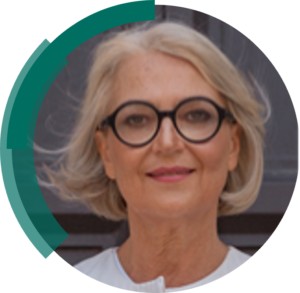
Luisa Torsi is a professor of analytical chemistry at the University of Bari and president of the Regional Center on Single-Molecule Digital Assay. She received her laurea degree in Physics and the PhD in Chemistry from UNIBA and was post-doctoral fellow at Bell Labs in USA.
In 2010 Torsi was awarded the Merck prize and in 2019, she received the Distinguished Women Award from the International Union of Pure and Applied Chemistry (IUPAC). She was also president of the European Material Research Society. Torsi is the winner of the Wilhelm Exner Medal 2021, a prize awarded since 1921 by the Austrian Industrial Association and the Premio del Presidente della Repubblica dell’Accademia dei Lincei. She is also a member of this prestigious Accademia since 2023
Torsi has authored ca. 240 papers, published also in Science and Nature journals. Her works collected mare then 16.400 Google Scholar citations resulting in an h-index of 63. Gathered research funding for over 40 M€, comprises several national and European projects, mostly coordinated by her. Torsi is committed to the role-modeling for younger women scientists. In a recent campaign by Fondazione Bracco, she was featured in a story of TOPOLINO (Italian series of Disney comics), as “Louise Torduck”, a successful female scientist of the Calisota valley.
Where do you see the materials chemistry field in the next 10 years?
‘I believe that a forthcoming challenge in the field will revolve around delving into the molecular-level investigation and comprehension of the electrostatic characteristics of proteins, especially when they are constrained to a surface or when they come together to create a biolayer.’
Could you provide a summary of your most recent Materials Horizons publication?
‘It a reflection on the comparison between electronic and electrochemical biosensors. It starts from the observation that several three-terminal organic bioelectronic structures have been proposed for diverse biosensing applications, with a focus on organic field-effect transistors in an electrolyte as popular choices for detecting proteins and genomic analytes. These devices gain selectivity by immobilizing bio-recognition elements and are cost-effective for point-of-care medical uses. However, they don’t consistently outperform traditional electrochemical sensors. The idea is to provide the community with a comparative analysis of potentiometric and amperometric electrochemical sensors against organic bioelectronic transistors, including an examination of their sensing mechanisms and amplification factors. It also discusses the functional relationship between sensor responses and analyte concentration for accurate quantification.’
Here are some of Luisa’s latest articles from across the Materials journals:
About the amplification factors in organic bioelectronic sensors.
Eleonora Macchia, Rosaria Anna Picca, Kyriaki Manoli, Cinzia Di Franco, Davide Blasi, Lucia Sarcina, Nicoletta Ditaranto, Nicola Cioffi, Ronald Österbacka, Gaetano Scamarcio, Fabrizio Torricelli and Luisa Torsi.
Mater. Horiz., 2020,7, 999-1013. DOI: 10.1039/c9mh01544b
A stable physisorbed layer of packed capture antibodies for high-performance sensing applications.
Lucia Sarcina, Cecilia Scandurra, Cinzia Di Franco, Mariapia Caputo, Michele Catacchio, Paolo Bollella, Gaetano Scamarcio, Eleonora Macchia and Luisa Torsi.
J. Mater. Chem. C, 2023,11, 9093-9106. DOI: 10.1039/d3tc01123b
We hope you have enjoyed meeting our Advisory board members. Next month we take a look at some more of our featured Materials Horizons Emerging Investigators.
Or to read more of our community spotlight blog, return to the home page here


